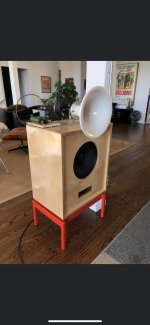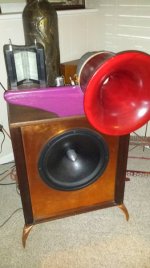I am a total noob when it comes to DIY speakers, or really the innards of speakers in general. My goal is build my own speakers and have fun doing it. I wanted to run an idea past you all and see what you thought. I'm sure it will get blank stares and head scratches.
I love vintage equipment, and high quality drivers can be found on Fleabay for very cheap. In my mind, the price to quality ratio is far higher than buying speaker kits online. So what I'd like to do is create a vintage 3-way Frankenspeaker using a cabinet I make myself and any high quality drivers I can find online. My basic question is, what are my biggest considerations? I know that each driver needs to be rated the same, correct? Such as 8 ohm?
What I'd like for my design is an exposed horn on top, and a cabinet with a tweeter and woofer underneath. Something like the attached image. Does any of this make sense? 😀
I love vintage equipment, and high quality drivers can be found on Fleabay for very cheap. In my mind, the price to quality ratio is far higher than buying speaker kits online. So what I'd like to do is create a vintage 3-way Frankenspeaker using a cabinet I make myself and any high quality drivers I can find online. My basic question is, what are my biggest considerations? I know that each driver needs to be rated the same, correct? Such as 8 ohm?
What I'd like for my design is an exposed horn on top, and a cabinet with a tweeter and woofer underneath. Something like the attached image. Does any of this make sense? 😀
Attachments
Since you are new, most of us would recommend going with a proven design. In the genre of what you are looking for the Econowave is a great place to start.
It all makes perfect sense, but working towards your goal would require the accumulation of a great amount of knowledge about speaker driver types, crossover networks and cabinet designs - too much to expect of a thread such as this.Does any of this make sense? 😀
I am sympathetic with your ambition to utilise vintage drivers, but matching bass, midrange and treble drivers is much more complicated than simply ensuring they are all 8Ω units.
Also, the electrical and mechanical specifications of vintage drivers are rarely known, making cabinet design difficult, if not impossible.
For that reason, when employing vintage drivers, it is best to stick to the original, vintage cabinet designs intended for those drivers.
I suggest you do some research on the subject prior to purchasing a set of vintage drivers which turn out to be incompatible with each other.
Look at vintage designs from manufacturers of the likes of Wharfedale, whose vintage drivers appear frequently at auction.
http://ukhhsoc.torrens.org/makers/Wharfedale/Wharfedale_cabinet_construction_sheet_October_1965.pdf
What I'd like for my design is an exposed horn on top, and a cabinet with a tweeter and woofer underneath. Something like the attached image. Does any of this make sense? 😀
To answer directly ... no it doesn't.
Speakers are both difficult and expensive to build.
Most people's first builds turn out to be pretty bad because they don't actually know what's going on with the cabinet sizes and shapes, the driver behaviour or the crossover circuitry. So they slap together a box, cut a hole and screw a speaker over it then sit back and wonder why it sounds like crap.
Then they discover the computer simulations for designing speakers and crossovers. But without any founding in theory or experience, they take the sims and build directly, forgetting that simulations are only starting points, not finished designs. (In fact, you will find this all over you tube with guys touting their latest and greatest mediocre products.)
Your best bet, if you want to successfully build a decent set of speakers is to do your homework first. Learn why things are done as they are... and not done as they aren't... Get a bit of acoustic theory and electronics theory to help you understand the box and crossover designs so that you aren't totally reliant upon simulations for your projects.
Start with a pretty standard speaker configuration. Build it, test it, improve it... and then, using that experience you can begin to look at more exotic designs. Except this time you will see them with a more knowing eye...
Last edited:
These are all extremely helpful responses. Thank you! I think it's definitely a great idea to start with a simpler project and work my way up. This is something I want to turn into a lifelong endeavor, not just a flash in the pan experiment. So I will do my homework and try to learn as much as I can.
I think an econowave conversion seems like the best way to start. I actually already have some vintage loudspeakers lying around and will see about upgrading them in the style of this tutorial:
Econowave Speakers | Make:
I have also seen plans for DIY Bluetooth speakers, so that might be a good place to start, too.
I do appreciate the responses and look forward to learning with you all.
I think an econowave conversion seems like the best way to start. I actually already have some vintage loudspeakers lying around and will see about upgrading them in the style of this tutorial:
Econowave Speakers | Make:
I have also seen plans for DIY Bluetooth speakers, so that might be a good place to start, too.
I do appreciate the responses and look forward to learning with you all.
The problem I've found with some of the AK threads is that some of the links are dead...
Those speakers are awesome!
Those speakers are awesome!
If you like the look and style of the speaker in your first post (I do) then following the econowave is a smart choice. You won't have to plow thru rocky fields, a lot of other people have been in there clearing the obstacles. There is hard won, good advice in the posts above. See especially the last paragraph of Douglas' post above.
Once you have a working set of speakers as a reference, you can begin to experiment. A small multi-cell horn on the top of that box, perhaps? 😉
Once you have a working set of speakers as a reference, you can begin to experiment. A small multi-cell horn on the top of that box, perhaps? 😉
Not your biggest and not even essential, merely a sensible starting point. Power is also overrated (no pun intended 🙂)what are my biggest considerations? I know that each driver needs to be rated the same, correct? Such as 8 ohm?
More of interest is what sound you get per frequency, ie what makes a driver useful to you and what part can it play in a speaker system. You may also want to know what input is required to get this output.
- Home
- Loudspeakers
- Multi-Way
- Vintage Frankenspeakers

